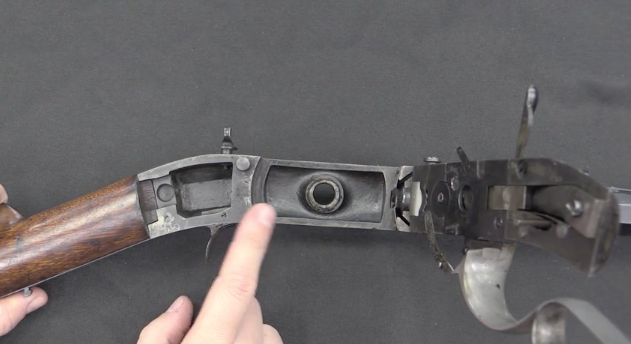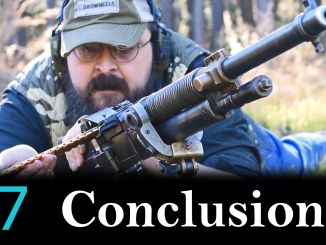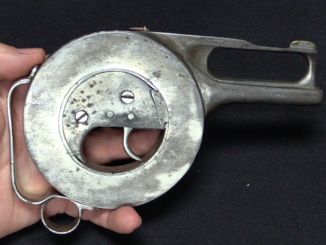I recently had a chance to take a .36 caliber Colt Model 1855 revolving rifle our to the range. It was pretty interesting to shoot, but unfortunately the video ended up rather sub-par and I didn’t realize it until after we had left the range and I didn’t have a chance to redo it. Rather than toss the footage out, I figured I would just release it as a bonus Sunday video. So with apologies for the framing, audio, and lack of loading sequence video, here you go…
Related Articles

Percussion
RIA: Porter Turret Rifle
The Porter was one of the few turret rifles ever put into serial production. Turret rifles are similar in principle to revolvers, but they is a cylinder with radial chambers (like the spokes of a […]

Light MGs
Project Lightening Episode 07: Conclusions
Project Lightening is a collaborative series with Othais and Mae of C&Rsenal in which we test all seven light machine guns and automatic rifles of World War One and put them through a series of […]

Prototype
McCarty’s Peculiar Revolver
William McCarty patented this turret revolver design in 1909 (submitted in 1908, approved in 1909), with the idea of making a high capacity revolver. His gun held 18 rounds of .22 rimfire ammunition – double […]

I have been a muzzleloader since 1969 and have owned one reproduction Colt 1851 in 36 caliber. I shot it quite a bit and I knew about the danger of chain fire but never experienced one. Probably because I always squeezed a glob of Vaseline in front of every ball. It was messy, but it worked. I was alway intrigued with the Colt revolving rifle, but this video was the first time I was able to see one fired except in movies. Thanks for the demonstration.
Chain fire in percussion revolvers is nothing to do with flashing over the chamber mouths (lubed or not lubed). It happens when a live cap on a chamber next to the one being fired falls off its nipple, and the nipple flash of the firing chamber flashes over, makes its way down the nipple hole and ignites the powder. If you see slow motion footage of a percussion revolver firing, it is striking how much flash and blast occurs around the hammer and nipple area.
If you don’t want it to happen, make sure caps fit firmly on nipples. Some shooters even give them a slight squeeze before fitting.
Some thirty years ago I picked up a second-hand 1851 replica as my first black powder gun, and on my first outing with it my day was cut short with a multiple discharge. On disassembly I found one nipple missing from the cylinder, which would support the chain fire coming through the nipple – in this case, it was probably loose.
I had a Navy Arms 1851 for time in the 70s, and experienced one multiple-discharge. It was not due to cylinder face flash-over, as they were all sealed with beeswax. My impression was that it resulted from the percussion cap of the fired chamber being blown off the nipple with enough force to sufficiently cycle the hammer and index the cylinder (with the trigger still depressed, of course). I would think that the historical record would have ample details on the various possible scenarios.
I had 2 replica Colt 1851 revolvers in .36. and I used either Crisco or RIG grease over the balls and the caps. Messy, but waterproof. Never had a multiple discharge. A couple of years ago at a range, the guy next to me had a double discharge with a Rogers and Spencer replica. We heard it, but no damage. He was not greasing the balls or caps.
Good application for shooting sticks or a forked rest.
Antebellum VFG?
I shoot a Remington New Model Army replica and with a .454 round ball that’s mechanical fit in the chambers no grease on top is required. Undersized ball or no cap on loaded chamber next to the chamber being fired might cause a chain fire but otherwise just no. Just another black powder shooting myth.
“(…)replica(…)”
I want to note that these are made using modern technology, which allow tolerances beyond capabilities of 1850s manufacturers.
However the originals would have been using a a heeled conical bullet with a combustible paper cartridge not a loose round ball like we do today.
I have a modern Rossi Circuit Judge revolving carbine in .45 Colt/.410. This uses cartridges and shells, instead of being a front-stuffer. The exhaust from the cylinder gap is deflected from the user’s offhand forearm by a couple of metal flanges, which allows a proper rifle grip. Perhaps because of these steel projections, this is the strangest-sounding gun I have ever heard fired.
Once I bought a 15 inch barrel for my Dan Wesson. I couldnt hold it accurately without supporting the barrel. The first shot I took taught me all I need to know about having your arm exposed to the flash from the cylinder gap. I belive that is why a revolving rifle never caught on.
I’ve read Walden 200 times… Just getting it; Anyway, this is sure high tech for 1854/5. “He’s right about the railroad* though” it runs over us.
*= Tech, in general.
“Something to be said for staying at home, and minding your own business. After reading it “and enjoying it; great to hear someone talk from 166 years ago”
Yes he would also like the repeater… I will read it another 200 times, and clarify that.
Fair comment. As I have read Walden 200 times. And it is great to listen to somebody “which you can with Walden; albeit after 200 times” talk, from 166 years ago. Like it’s now.
We don’t ride it “The Railroad” it rides over us. Not especially profound; however if you think why… We let it, ride over us.
Well its well worth reading 200 times; you could be there for 200 years he he.
Thoreau was pretty selective about which technology he disliked, considering that pencil making machinery made him rich.
Fair point “I knew that” still… All good. I do find reading Walden more, to be of benefit. And like pencils are usefull, he he.
He said he’s the worst man he ever met, so critcism… Is apt, as with anyone. I must say though it is a great book, if you read it… Again, he he. And so on; eventually you do meet the author, which is interesting as he’s long gone and from the U.S which I am not, so it is perhaps even more interesting. Especially with hindsight… Love to bring him back now to look at the States. Bet he’d drink more, ha.
https://youtu.be/hZ1OgQL9_Cw
1911 NYC… He he. Whiskey, he he.
I love the book but am immensely annoyed by the civil disobedience myth that Thoreau let grow up around him. He refused to pay a poll tax. He spent one night in jail. His auntie paid the tax for him and he walked.The stuff of heroism and high moral purpose? He sounds like a virtue signalling college kid in 2024.
Come on.
Ian is too self-critical.
Normal video.
Perhaps not the best for auction advertising, but quite informative and interesting.
Thanks always.
It’s a bit “a pity” that chain firing didn’t work out …
But this is fixable.
https://youtu.be/arx-PwjSajE?t=191
Not saying its “the answer”, but…can’t you hold the fore end up with your arm directly under the frame, (like a modern target shooter) and avoid enough flash and debris to make it completely acceptable to the 19th century shooter’s less delicate sensibilities?
Not that this would help in the event of a chain fire, of course.
kinda partially defeats the purpose of a longer gun if you cant increase your hold on it.
You could perhaps mount a wee “foregrip” handle… Off the trigger guard; \ angle’ish. Might help. Mind you at the time; bet everyone just went with the normal forestock and figured this is mint!
You would really after a single shot, you’d be well chuffed with this Colt.
https://clickamericana.com/wp-content/uploads/1907-George-Custer-kneeling-on-left-and-soldiers-shooting-at-indians-soldier-in-center-is-carrying-a-wounded-soldier.-1-750×467.jpg
https://capandball.com/wp-content/uploads/2020/11/us-cavalry-skirmish.jpg
If you look at the shooting techniques of cavalrymen in those years, it may seem that the forearm is not very necessary.
But already on the second model Henry (Winchester) in 1867 the forend appeared.